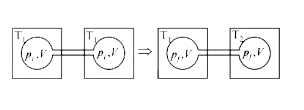Two closed vessels of equal volume containing air at pressure P1 and temperature T1 are connected to each other through a narrow tube. If the temperature in one of the vessels is now maintained at T1 and that in the other at T2, what will be the pressure in the vessels?
2P1T2T1+T2
2P1T1+T2
2P1T2T1+T2
none of these
The correct Answer is:C
Step by step video & text solution for Two closed vessels of equal volume containing air at pressure P_(1) and temperature T_(1) are connected to each other through a narrow tube. If the temperature in one of the vessels is now maintained at T_(1) and that in the other at T_(2), what will be the pressure in the vessels? by Chemistry experts to help you in doubts & scoring excellent marks in Class 12 exams.
Similar Questions
Two closed vessels of equal volume contain air at P0 pressure, T0 temperature and are connected through a narrow tube, If one of the vessels is now maintained at T0 and other at T, what will be the pressure in the vessels?
View SolutionTwo closed vessels of equal volune contain air at 105kPa, 300K and are connected through a narrow tube. If one of the vessels is mow maintained at 300K and the other at 400K, what will be the pressure in the vessels?
View Solution
Knowledge Check
- Question 1 - Select One
Two closed bulbs of equal volume (V) containing an ideal gas initially at pressure pi and temperature T1 are connected through a narrow tube of negligible volume as shown in the figure below. The temperature of one of the bulbs is then raised to T2. The final pressure pf is:
 A2p,(T2T1+T2)B2p,(T1T2T1+T2)Cp,(T1T2T1+T2)D2p,(T1T1+T2)
A2p,(T2T1+T2)B2p,(T1T2T1+T2)Cp,(T1T2T1+T2)D2p,(T1T1+T2) - Question 2 - Select One
Two closed bulbs of equal volume (V) containing an ideal gas initially at pressure Pi and temperature T1 are connected through a narrow tube of negligible volume as shown in the figure below. The temperature of one of the bulbs is then raised to T2. The final pressure Pf is :
 Api(T1T2T1+T2)B2pi(T1T1+T2)C2Pi(T2T1+T2)D2pi(T1T2T1+T2)
Api(T1T2T1+T2)B2pi(T1T1+T2)C2Pi(T2T1+T2)D2pi(T1T2T1+T2) - Question 3 - Select One
Two closed bulb of euqal volume (V) containing an ideal gas initially at pressure pi and Temperature T1 are connected through a narrow tube of negligible volume as shown in the figure below. The temperature of one of the bulbs is then released to T2. The final pressure pt is :
 A2pi(T1T1+T2)B2pi(T2T1+T2)Cpi(T1T2T1+T2)D2pi(T1T2T1+T2)
A2pi(T1T1+T2)B2pi(T2T1+T2)Cpi(T1T2T1+T2)D2pi(T1T2T1+T2)
Two closed bulbs of equal volume (V) containing an ideal gas initially at pressure pi and temperature T1 are connected through a narrow tube of negligible volume as shown in the figure below. The temperature of one of the bulbs is then raised to T2. The final pressure pf is:
 View Solution
View SolutionEqual masses of air are sealed in two vessels, one if volume V0and the other of volume 2V0.If the first vessel is maintained at a temperature 300K and the other at 600K, find the ratio of the pressures in the two vessels.
View SolutionTwo closed containers of equal volume of air are initially at 1.05×105 Pa, and 300 K temperature. If the containers are connected by a narrow tube and one container is maintained at 300 K temperature and other at 400 K temperature. Find the final pressure in the containers.
View SolutionTwo vessels of capactie 1.5 L and 2.0 L containing hydrogen at 750 mm pressure and oxygen at 100 mm pressure, respectivity are connected to each other through a valve. What will be the final pressure of the gaseous mixture assuming that the temperature remains constant?
View SolutionA closed vessel A having volume V contains N2 at pressure P and temperature T. another closed vessel B having the same volume V contains. He at the same pressure P. but temperature 2T. The ratio of masses of N2 and He in the vesses A and B is
View Solution
